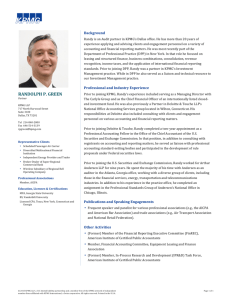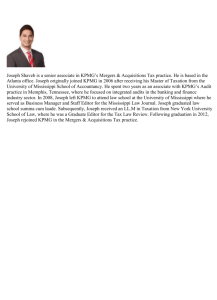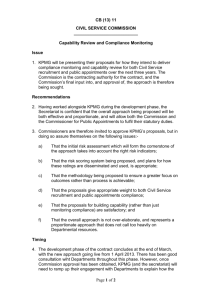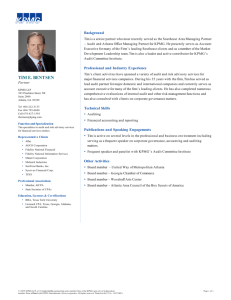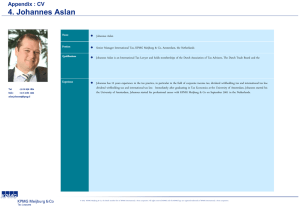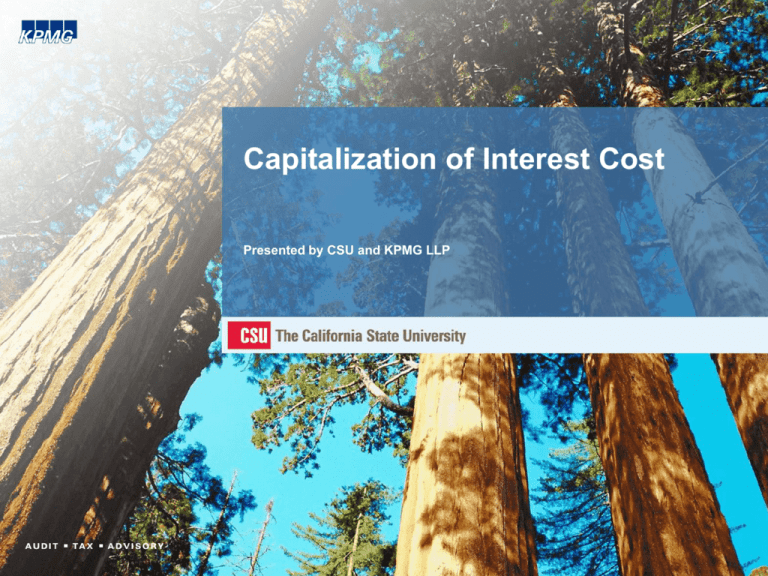
Capitalization of Interest Cost
Presented by CSU and KPMG LLP
Capitalization of Interest Cost
FASB Statement No. 34:
Established standards for capitalizing interest cost as part of
the historical cost of acquiring certain assets.
To qualify for interest capitalization, assets must require a
period of time to get them ready for their intended use.
The interest cost eligible for capitalization shall be the interest
cost recognized on borrowings and other obligations.
The amount capitalized is to be an allocation of the interest
cost incurred during the period required to complete the
asset.
The amount of interest cost to be capitalized for qualifying
assets is intended to be that portion of the interest cost
incurred during the assets' acquisition periods that
theoretically could have been avoided (for example, by
avoiding additional borrowings or by using the funds
expended for the assets to repay existing borrowings) if
expenditures for the assets had not been made.
© 2008 KPMG LLP, the U.S. member firm of KPMG International, a Swiss cooperative. All rights reserved.
Printed in U.S.A. KPMG and the KPMG logo are registered trademarks of KPMG International.
2
August 2008
GAAP Reporting Workshop
Capitalization of Interest Cost
FASB
Assets Qualifying for Interest Capitalization (“qualifying
assets”)”
Interest shall be capitalized for the following types of
assets ("qualifying assets"):
– Assets that are constructed or otherwise produced
for an enterprise's own use (including assets
constructed or produced for the enterprise by others
for which deposits or progress payments have been
made)
– Assets intended for sale or lease that are
constructed or otherwise produced as discrete
projects (e.g., ships or real estate developments).
The average amount of accumulated expenditures for the
qualify assets is then calculated for the year
© 2008 KPMG LLP, the U.S. member firm of KPMG International, a Swiss cooperative. All rights reserved.
Printed in U.S.A. KPMG and the KPMG logo are registered trademarks of KPMG International.
Statement No. 34, Continued:
3
August 2008
GAAP Reporting Workshop
Capitalization of Interest Cost
FASB Statement No. 34, Continued:
Interest Rate For Capitalization Purposes (“the capitalization
rate”)
The capitalization rates used in an accounting period shall be
based on the rates applicable to borrowings outstanding during
the period.
If an enterprise's financing plans associate a specific new
borrowing with a qualifying asset, the enterprise may use the
rate on that borrowing as the capitalization rate to be applied to
that portion of the average accumulated expenditures for the
asset that does not exceed the amount of that borrowing.
If average accumulated expenditures for the asset exceed the
amounts of specific new borrowings associated with the asset,
the capitalization rate to be applied to such excess shall be a
weighted average of the rates applicable to other borrowings of
the enterprise.
The amount capitalized in an accounting period shall be
determined by applying the capitalization rate to the average
amount of accumulated expenditures for the asset during the
period.
© 2008 KPMG LLP, the U.S. member firm of KPMG International, a Swiss cooperative. All rights reserved.
Printed in U.S.A. KPMG and the KPMG logo are registered trademarks of KPMG International.
4
August 2008
GAAP Reporting Workshop
Capitalization of Interest Cost
FASB Statement No. 34, Continued:
The Capitalization Period
The capitalization period shall begin when three
conditions are present:
a.
Expenditures (as defined in paragraph 16 of FASB No.
34) for the asset have been made.
b.
Activities that are necessary to get the asset ready for its
intended use are in progress.
c.
Interest cost is being incurred.
The capitalization period shall end when the asset is
substantially complete and ready for its intended use.
© 2008 KPMG LLP, the U.S. member firm of KPMG International, a Swiss cooperative. All rights reserved.
Printed in U.S.A. KPMG and the KPMG logo are registered trademarks of KPMG International.
5
August 2008
GAAP Reporting Workshop
Capitalization of Interest Cost
FASB
Requires capitalization of interest cost of restricted taxexempt borrowings less any interest earned on
temporary investment of the proceeds of those
borrowings from the date of borrowing until the
specified qualifying assets acquired with those
borrowings are ready for their intended use.
Prohibits capitalization of interest cost on qualifying
assets acquired using gifts or grants that are restricted
by the donor or grantor to acquisition of those assets.
© 2008 KPMG LLP, the U.S. member firm of KPMG International, a Swiss cooperative. All rights reserved.
Printed in U.S.A. KPMG and the KPMG logo are registered trademarks of KPMG International.
Statement No. 62 amends FASB
Statement No. 34 as follow:
6
August 2008
GAAP Reporting Workshop
Four Key Categories
Campus needs to determine if the capitalization
of interest is required for projects that are
contained in its Construction Work in Progress
(CWIP) accounts. CWIP accounts can be
broken out into 4 key categories:
1)
Projects acquired using gifts, grants or State
of California capital appropriations
2)
Projects funded with taxable debt
3)
Projects funded with tax-exempt debt
4)
Projects that are self-funded by the campus
with multiple funding sources
© 2008 KPMG LLP, the U.S. member firm of KPMG International, a Swiss cooperative. All rights reserved.
Printed in U.S.A. KPMG and the KPMG logo are registered trademarks of KPMG International.
7
August 2008
GAAP Reporting Workshop
Category 1
Projects acquired using gifts, grants or State
of California capital appropriations
*
No interest capitalization required *
Paragraph 5 of FASB No. 62 amended FASB No.34 and added the following sentence to paragraph
10 of FASB 34 which specifies the types of assets for which interest is not capitalized: (f) Assets
acquired with gifts and grants that are restricted by the donor or grantor to acquisition of those assets
to the extent that funds are available from such gifts and grants.
© 2008 KPMG LLP, the U.S. member firm of KPMG International, a Swiss cooperative. All rights reserved.
Printed in U.S.A. KPMG and the KPMG logo are registered trademarks of KPMG International.
1)
8
August 2008
GAAP Reporting Workshop
Category 2
Projects funded with taxable debt
Determine qualifying assets, capitalization rate and
capitalization period (see slides 3, 4 and 5)
Determine the amount of interest to capitalize by multiplying
the capitalization rate to the average amount of accumulated
expenditures for the asset during the period.
If the campus associates a specific new borrowing with a
qualifying asset, the campus may use the rate on that
borrowing as the capitalization rate to be applied to that portion
of the average accumulated expenditures for the asset that
does not exceed the amount of that borrowing.
If average accumulated expenditures for the asset exceed the
amounts of specific new borrowings associated with the asset,
the capitalization rate to be applied to such excess shall be a
weighted average of the rates applicable to other borrowings of
the enterprise.
Finally, capitalize the interest cost calculated above.
Interest capitalization is not required if its effect, compared with
the effect of expensing the interest, is immaterial.
© 2008 KPMG LLP, the U.S. member firm of KPMG International, a Swiss cooperative. All rights reserved.
Printed in U.S.A. KPMG and the KPMG logo are registered trademarks of KPMG International.
2)
9
August 2008
GAAP Reporting Workshop
Category 2 - Example
Projects funded with taxable debt
Example (taxable revenue bond) from the passdown schedule
Step 1
Compute Average Accumulated Expenses
CWIP at 6/30/07
A
$0
CWIP at 6/30/08
B
$6,500,000
AAE
(A+B)/2 $
3,250,000
Step 3
Compute avoidable interest:
AAE
$
3,250,000 (taxable bond) x 5.0%
C
$162,500
Step 2
Compute capitalization rate:
Rate on 2007B (taxable) - Bookstore
Step 4
Compute actual interest costs incurred during the year:
Obtain from passdown schedule
D
$141,360
5%
Interest That
S/B Capitalized
Step 5
Since C is greater than D, capitalized interest is limited to D
$141,360
Excerpt from campus passdown schedule
If campus records as presented in the passdown schedule, then the entry to record
the capitalization of interest cost is:
© 2008 KPMG LLP, the U.S. member firm of KPMG International, a Swiss cooperative. All rights reserved.
Printed in U.S.A. KPMG and the KPMG logo are registered trademarks of KPMG International.
2)
DR CWIP $141,360
CR Interest expense ($141,360)
10
August 2008
GAAP Reporting Workshop
Category 3
Projects funded with tax-exempt debt
Most likely result in interest capitalization
Capitalize interest cost less interest earned until
assets are ready for intended use
For the portion of interest costs and interest earnings
that are related to assets which have been placed in
service, entries are recorded as presented in the
pass down schedule.
For the portion of interest cost and interest earnings
that are related to CWIP, campus needs to capitalize
such amounts, i.e. to record the net amount as an
addition to CWIP.
© 2008 KPMG LLP, the U.S. member firm of KPMG International, a Swiss cooperative. All rights reserved.
Printed in U.S.A. KPMG and the KPMG logo are registered trademarks of KPMG International.
3)
11
August 2008
GAAP Reporting Workshop
Category 3 - Example
3)
Projects funded with tax-exempt debt (cont’d)
Example from passdown schedule
–
If campus records as presented in the passdown schedule, then the entry to
record the capitalization of net interest cost is:
DR Investment income
$1,458,602
CR Interest expense
($324,020)
© 2008 KPMG LLP, the U.S. member firm of KPMG International, a Swiss cooperative. All rights reserved.
Printed in U.S.A. KPMG and the KPMG logo are registered trademarks of KPMG International.
CR CWIP
($1,134,582)
Note: In this entry, the investment
earning is greater than the interest
expense, which results in a net
reduction to CWIP.
This
example
assumes
that the
qualifying
asset is in
CWIP
during the
entire
fiscal
year.
12
August 2008
GAAP Reporting Workshop
Category 4
Projects that are self-funded by the campus
with multiple funding sources
Calculate the interest that could have been
avoided (avoidable interest) if the qualifying assets
on which the interest is based had not been
constructed. The amount of interest that is
actually capitalized may not exceed the actual
interest cost incurred by the campus for the year.
No interest capitalization required if immaterial.
FASB Statement No. 34 and 62 are not applicable
if no debt is outstanding.
© 2008 KPMG LLP, the U.S. member firm of KPMG International, a Swiss cooperative. All rights reserved.
Printed in U.S.A. KPMG and the KPMG logo are registered trademarks of KPMG International.
4)
13
August 2008
GAAP Reporting Workshop
Category 4 - Example
2)
Projects that are self-funded by the campus with multiple funding sources
Assume the construction project X is to be financed through donor contribution, tax-exempt revenue bond at
a rate of 5%, and from fees. In the absence of other outstanding debt to compute the average interest rate
(Step 2), campus may use the 5% rate to calculate the interest expense. The outstanding debt is assumed
to have been outstanding the entire year.
Campus’ other outstanding debt during the year consist of $600,000 (CP equipment financing) and
$800,000 (Energy conservation project) with interest rates of 4% and 6.5%, respectively.
Campus incurred project X expenses as follow:
Dec 1
$200,000 (bond)
March 1
$400,000 (donor)
June 1
$120,000 (fees)
$
120,000 x 1/12 (June)
= $
10,000
-
AAE
= $
10,000
* The $400,000 of donor contributions were excluded from the
computation as FASB 62 does not permit the capitalization of
interest cost on any portion of a qualify asset acquired with a gift
or grant that is restricted to the acquisition of the specified
qualifying asset. The entire portion of the interest expense on the
$200,000 in bonds is netted with the interest earned on the
unspent bond proceeds (see Step 3).
Step 3
Compute avoidable interest:
Interest That
Tax-Exempt Debt Financed Expenditures
S/B Capitalized
$ 200,000 (bond) x 5.0%
= $
10,000
less: interest earned on bond proceeds =
(2,900)
$
7,100 **
$
540
7,640
Other Financed Expenditures
AAE:
$ 10,000 x 5.4%
** This would have been the interest capitalized in the example
on slide 12 related to the tax-exempt debt
Step 2
Step 4
Compute average interest rate (based on other outstanding debt):
Compute actual interest costs incurred during the year:
$
600,000 x 4.0%
= $
24,000
$ 200,000 x 5.0%
= $
800,000 x 6.5%
=
52,000
600,000 x 4.0%
=
$ 1,400,000
$
76,000
800,000 x 6.5%
=
Avg interest rate:
=
5.4%
Total
$
Because the avoidable interest is less than the campus' actual interest cost, the avoidable interest cost should be capitalized.
Journal Entry:
CWIP
Investment income
Interest expense
$
$
Debit (Credit)
7,640
2,900
$
10,000
24,000
52,000
86,000
© 2008 KPMG LLP, the U.S. member firm of KPMG International, a Swiss cooperative. All rights reserved.
Printed in U.S.A. KPMG and the KPMG logo are registered trademarks of KPMG International.
Step 1
Compute Average Accumulated Expenses, Excluding Expenditures
Acquired with Tax-Exempt Debt (AAE) *:
(10,540)
14
August 2008
GAAP Reporting Workshop
References
Financial Accounting Services Training, Education &
Development Portal
https://zeta.calstate.edu:8250/portal/page?_pageid=74,
1&_dad=portal&_schema=PORTAL
GAAP Manual 2008
http://www.calstate.edu/SFSR/GAAP/Manual2008/GAA
P_Manual.shtml
© 2008 KPMG LLP, the U.S. member firm of KPMG International, a Swiss cooperative. All rights reserved.
Printed in U.S.A. KPMG and the KPMG logo are registered trademarks of KPMG International.
15
August 2008
GAAP Reporting Workshop
Questions and Answers
How should investment earnings from the operating fund used for capital projects be
treated?
Should capitalized lease obligations be used in calculating the weighted average rate
for self-funded projects?
Interest related to a capital lease determined in accordance FASB 13 should be
included in the calculation, assuming the interest is related to a qualifying asset.
Can SRB financed auxiliary projects for which the campus does not hold the assets,
but rather a note or lease receivable be excluded as part of campus’ debt in
calculating the weighted average rate for self-funded projects?
Investment earnings from the operating fund used for capital projects do not meet the
criteria from paragraph 5, FASB 62 as gifts or grants. Therefore, it should be treated
as self funded.
Given the nature of the SRB financed auxiliary projects which doesn't represent
capital asset activity on the University's books and which is offset with a
corresponding note receivable between the university and the auxiliary, an argument
can be made to exclude the rates on these borrowings from the weighted average
rate calculation.
Should interest cost be included in the CWIP and allocated to the campus for
projects financed by the CO, in which the CO records the debt and passdown the
CWIP to the campuses?
capitalized interest costs should be allocated to the campus.
© 2008 KPMG LLP, the U.S. member firm of KPMG International, a Swiss cooperative. All rights reserved.
Printed in U.S.A. KPMG and the KPMG logo are registered trademarks of KPMG International.
16
August 2008
GAAP Reporting Workshop

